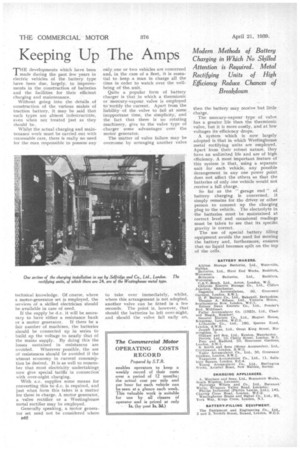Keeping Up The Amps.
Page 98

If you've noticed an error in this article please click here to report it so we can fix it.
THE developments which have been made during the past few years in electric vehicles of the battery type have been due, largely, to improvements in the construction of batteries and the facilities for their efficient charging and maintenance.
Without going into the details of construction of the various makes of traction battery, it may be said that such types are almost indestructible, even when not treated just as they should he.
Whilst the actual charging and maintenance work must be carried out with reasonable care, there is really no need for the man responsible to possess any
technical knowledge. Of course, where a motor-generator set is employed, the services of a skilled electrician should be available in case of need.
If the supply he d.c. it will be necessary to have either a resistance bank or a motor generator. If there be a fair number of machines, the batteries should be connected up in series to build up the voltage to nearly that of the mains supply. By doing this the losses sustained in resistances are
avoided. Wherever possible, the use of resistances should be avoided if the utmost economy in current consumption be desired. It is as well to remember that most electricity undertakings‘ now give special tariffs in connection with over-night charging.
With a.c. supplies some means for converting this to d.c. is required, and just what form this takes is a matter for those in charge. A motor generator, a valve rectifier or a Westinghouse metal rectifier may be employed.
Generally speaking, a motor generator set need not be considered where only,one or two vehicles are concerned and, in the case of a fleet, it is essential to keep a man in charge all the time in order to watch over the wellbeing of the unit.
Quite a popular form of battery charger is that in which a thermionic or mercury-vapour valve is employed to rectify the current. Apart from the liabilityof the .valve to .fail at some inopportune time, the simplicity, and the fact that there is no rotating machinery, give to the valve type of charger some advantages over the motor generator.
The matter of valve failure may be overcome by arranging another valve to take over immediately, whilst, where this arrangement is not adopted, another valve can be fitted in a few seconds. The point is, however, that should the batteries be left over-night, and should the valve fail early on, then the battery may receive but little charge.
The mercury-vapour type of valve has a greater life than the therrnionic valve, but it is more costly, and at low voltages its efficiency drops.
A system which is now largely adopted is that in which Westinghouse metal rectifying units are employed. Apart from their robust nature, they have an unlimited life and are of high efficiency. A most important feature of this system is that, using a separate unit for each vehicle, any possible derangement in any one power point does not affect the others so that the batteries of only one vehicle would not receive" a full charge.
So far as the " garage end " of battery charging is concerned, it simply remains for the driver or other person to connect up the charging, plug to the vehicle. The electrolyte in the batteries must be maintained at correct level and occasional readings must be taken to see that its specific gravity is correct. The use of special battery filling equipment avoids the need for moving the battery and, furthermore, ensures that no liquid becomes spilt on the top of the cells.






































































































































